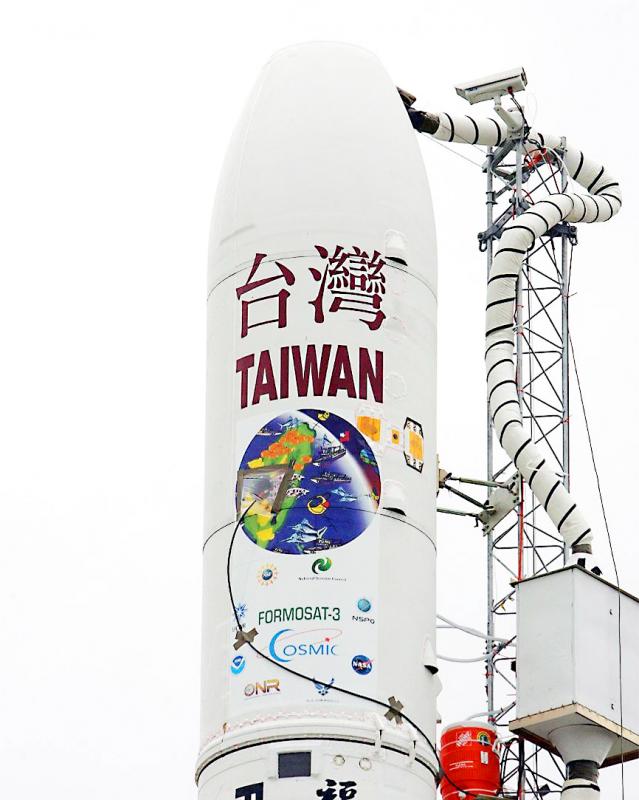The Formosat-3/COSMIC satellite constellation, a Taiwan-US collaboration, is to officially retire today, with the Formosat-7/COSMIC-2 constellation taking over its weather observation mission, the National Space Organization (NSPO) said yesterday.
The six-satellite Formosat-3 constellation was launched on April 15, 2006, atop a Minotaur rocket from Vandenberg Air Force Base in California.
Its original mission was to end after five years, but it has far outlived its expected life span, with only one satellite, the FM6, intermittently producing limited meteorological radio occultation data, said the NSPO, an agency under the National Applied Research Laboratories.

Photo courtesy of the National Applied Research Laboratories
The NSPO is to determine if FM6 — the only one that can still receive signals — can be recalled to be burned up in the atmosphere, NSPO Deputy Director-General Yu Shiann-jeng (余憲政) told the Taipei Times.
The agency has already lost communication with the other five satellites, Yu said.
The agency and the US National Oceanic and Atmospheric Administration decided to terminate the satellite’s functions, ending its data transmission and upload capabilities, the NSPO said.
Formosat-3’s accuracy and stability was recognized by the global meteorology community, with the European Centre for Medium-Range Weather Forecasts (ECMWF) in 2012 calling it the fifth-best meteorological observation system.
Despite generating a relatively small volume of data — about 2 to 3 percent of all data used in weather forecasting — Formosat-3 contributed to reducing forecast errors by 10 percent, the ECMWF said.
It assisted the US government in making emergency evacuation decisions with its accurate prediction of Hurricane Sandy’s trajectory in 2012, the NSPO said.
“As of Monday last week, there are 4,551 registered community users from 92 nations that used the data,” the NSPO said.
The constellation set an excellent lifetime record and has been mentioned in numerous papers featured in leading academic journals, such as Nature and Science, as well as publications focused on atmospheric science and engineering, it added.
The Formosat-7 constellation, which is also comprised of six satellites, was launched on June 25 last year.
Data gathered by Formosat-7 has been publicly available since March 7.
The Central Weather Bureau’s data analysis center daily releases all meteorological data gathered from the previous day, allowing research facilities to apply to research extreme or abnormal weather patterns; the formation of typhoons and their paths; and predictions and analysis for heavy rainfall, the NSPO said.
Additional reporting by Lin Chia-nan

US climber Alex Honnold is to attempt to scale Taipei 101 without a rope and harness in a live Netflix special on Jan. 24, the streaming platform announced on Wednesday. Accounting for the time difference, the two-hour broadcast of Honnold’s climb, called Skyscraper Live, is to air on Jan. 23 in the US, Netflix said in a statement. Honnold, 40, was the first person ever to free solo climb the 900m El Capitan rock formation in Yosemite National Park — a feat that was recorded and later made into the 2018 documentary film Free Solo. Netflix previewed Skyscraper Live in October, after videos

Starting on Jan. 1, YouBike riders must have insurance to use the service, and a six-month trial of NT$5 coupons under certain conditions would be implemented to balance bike shortages, a joint statement from transportation departments across Taipei, New Taipei City and Taoyuan announced yesterday. The rental bike system operator said that coupons would be offered to riders to rent bikes from full stations, for riders who take out an electric-assisted bike from a full station, and for riders who return a bike to an empty station. All riders with YouBike accounts are automatically eligible for the program, and each membership account

A classified Pentagon-produced, multiyear assessment — the Overmatch brief — highlighted unreported Chinese capabilities to destroy US military assets and identified US supply chain choke points, painting a disturbing picture of waning US military might, a New York Times editorial published on Monday said. US Secretary of Defense Pete Hegseth’s comments in November last year that “we lose every time” in Pentagon-conducted war games pitting the US against China further highlighted the uncertainty about the US’ capability to intervene in the event of a Chinese invasion of Taiwan. “It shows the Pentagon’s overreliance on expensive, vulnerable weapons as adversaries field cheap, technologically

NUMBERs IMBALANCE: More than 4 million Taiwanese have visited China this year, while only about half a million Chinese have visited here Beijing has yet to respond to Taiwan’s requests for negotiation over matters related to the recovery of cross-strait tourism, the Tourism Administration said yesterday. Taiwan’s tourism authority issued the statement after Chinese-language daily the China Times reported yesterday that the government’s policy of banning group tours to China does not stop Taiwanese from visiting the country. As of October, more than 4.2 million had traveled to China this year, exceeding last year. Beijing estimated the number of Taiwanese tourists in China could reach 4.5 million this year. By contrast, only 500,000 Chinese tourists are expected in Taiwan, the report said. The report